Click on the following button to get to the offer of this German-speaking host.
County: Hunedoara
Telefon: +40 (0)730 270 963
Address: Str. Codrului, nr. 25 , Orastie, Romania
Email: office@arsenalpark.ro
Our UiR database: You can also visit and explore nearby ...

Deva | Fortress and city in Hunedoara County
(09 December 2025)

Corvin Castle / Fortress in Hunedoara
(08 December 2025)
X

(08 December 2025)
Hunedoara Castle (also known as Corvin Castle or Hunyadi Castle, German: Burg Eisenmarkt, Romanian: Castelul Corvinilor or Castelul Huniazilor, Hungarian: Vajdahunyadi vár) is one of the most important non-religious buildings in Transylvania.
https://urlaub-in-rumänien.de | https://welcome-to-romania.com
The stone castle was built on the remains of a 14th-century fortification and is located in the southwestern part of the city of Hunedoara (German name: Eisenmarkt) in western Romania.
https://urlaub-in-rumänien.de | https://welcome-to-romania.com
The stone castle was built on the remains of a 14th-century fortification and is located in the southwestern part of the city of Hunedoara (German name: Eisenmarkt) in western Romania.
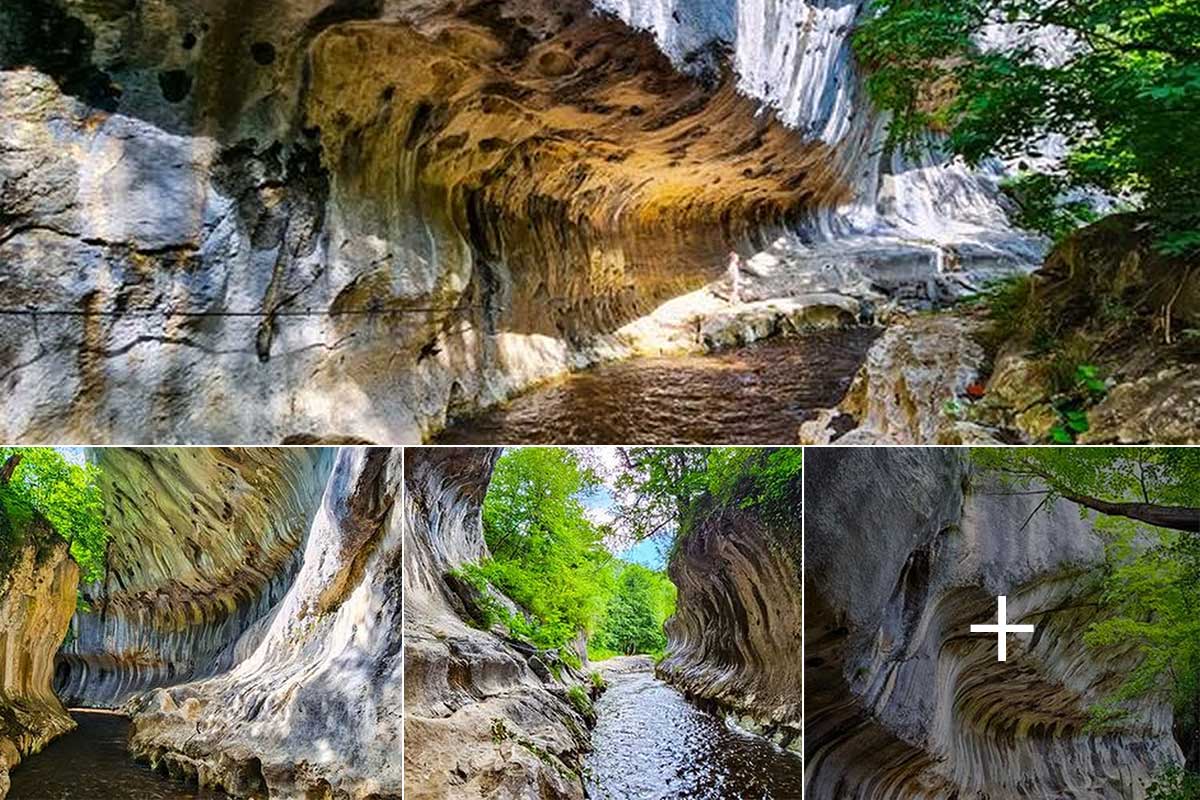
Banita Gorges | The Gorges of Banita
(26 November 2025)
X

(26 November 2025)
The gorges are located in the commune of Banita in Hunedoara County and run along high limestone walls.
They are about 300 meters long and have been deeply carved into the limestone by water. On calm summer days, they can be visited, but waterproof shoes are a must, as the path through the gorges also leads through water.
The height of the rock walls is about 10-15 meters and shows how the water eroded the stone. In many places, the rocks form a roof, which was created by horizontal erosion depending on the current over hundreds of years.
We thank Mrs. Corina E. Mateescu for granting permission to use these pictures.
They are about 300 meters long and have been deeply carved into the limestone by water. On calm summer days, they can be visited, but waterproof shoes are a must, as the path through the gorges also leads through water.
The height of the rock walls is about 10-15 meters and shows how the water eroded the stone. In many places, the rocks form a roof, which was created by horizontal erosion depending on the current over hundreds of years.
We thank Mrs. Corina E. Mateescu for granting permission to use these pictures.

Corvin Castle / Fortress in Hunedoara
(19 November 2025)
X

(19 November 2025)
The Hunedoara Castle (also known as Hunedoara Palace, in German Burg Eisenmarkt, in Romanian Castelul Corvinilor or Castelul Huniazilor, in Hungarian Vajdahunyadi var) is one of the most important non-religious buildings in Transylvania.
https://urlaub-in-rumänien.de | https://welcome-to-romania.com
The rock castle was built on the remains of a 14th-century fortification and is located in the southwestern part of the city of Hunedoara (German name: Eisenmarkt) in western Romania.
The listed castle has many other names (Corvin Castle, Castle of the Corvins, Corvinus Castle, Corvinesti Castle, Eisenmarkt Castle, Black Castle, Vajdahunyad Castle, Hunyadi Castle), which refer to its location or its owners.
The Hungarian statesman and military leader John Hunyadi converted an existing fortification into the ancestral seat of the Hunyadi family after 1440. In the second construction phase, the castle was expanded from 1458 under King Matthias Corvinus. At the beginning of the 17th century, further major alterations were made under Prince Gabor Bethlen. The present-day castle therefore shows a mixture of different architectural styles.
The castle was in Austrian possession from 1724 and has been in Romanian state ownership since 1918. In addition to being a tourist attraction, the castle has been and is used as a backdrop for numerous Romanian and international film productions. Today, the castle houses a museum.
https://urlaub-in-rumänien.de | https://welcome-to-romania.com
The rock castle was built on the remains of a 14th-century fortification and is located in the southwestern part of the city of Hunedoara (German name: Eisenmarkt) in western Romania.
The listed castle has many other names (Corvin Castle, Castle of the Corvins, Corvinus Castle, Corvinesti Castle, Eisenmarkt Castle, Black Castle, Vajdahunyad Castle, Hunyadi Castle), which refer to its location or its owners.
The Hungarian statesman and military leader John Hunyadi converted an existing fortification into the ancestral seat of the Hunyadi family after 1440. In the second construction phase, the castle was expanded from 1458 under King Matthias Corvinus. At the beginning of the 17th century, further major alterations were made under Prince Gabor Bethlen. The present-day castle therefore shows a mixture of different architectural styles.
The castle was in Austrian possession from 1724 and has been in Romanian state ownership since 1918. In addition to being a tourist attraction, the castle has been and is used as a backdrop for numerous Romanian and international film productions. Today, the castle houses a museum.

Deva | Hunedoara County | Impressions
(13 November 2025)

Castles | Fortresses | Fortified churches in Romania
(10 November 2025)
X

(10 November 2025)
Fans of castles, fortresses, palaces, and everything related will get their money’s worth on a holiday in Romania 🥰
Hunedoara / Corvin Castle, Hunedoara County | Bran Castle / Törzburg, Brasov County | Peles and Pelisor Castles, Sinaia, Prahova County | Cantacuzino Castle, Busteni, Prahova County | Fortified church of Biertan / Birthälm, Sibiu County | Defensive walls of Sibiu / Hermannstadt | Rasnov / Rosenau Fortress, Brasov County | and many other places invite you to visit.
https://urlaub-in-rumänien.de/de/ausflugsziele-reiseziele-rumaenien-burgen-schloesser/
Hunedoara / Corvin Castle, Hunedoara County | Bran Castle / Törzburg, Brasov County | Peles and Pelisor Castles, Sinaia, Prahova County | Cantacuzino Castle, Busteni, Prahova County | Fortified church of Biertan / Birthälm, Sibiu County | Defensive walls of Sibiu / Hermannstadt | Rasnov / Rosenau Fortress, Brasov County | and many other places invite you to visit.
https://urlaub-in-rumänien.de/de/ausflugsziele-reiseziele-rumaenien-burgen-schloesser/

Deva | Fortress and town in Hunedoara County
(05 November 2025)
X

(05 November 2025)
Beautiful pictures of Deva Fortress by Mr. Iercosan Marian from a few days ago (end of September 2025) 🥰
This and many other destinations (as of today: more than 420) in Romania can be found here > [https://rotravel24.com/rumaenien-bucket-list-top-reiseziele/](https://rotravel24.com/rumaenien-bucket-list-top-reiseziele/)
This and many other destinations (as of today: more than 420) in Romania can be found here > [https://rotravel24.com/rumaenien-bucket-list-top-reiseziele/](https://rotravel24.com/rumaenien-bucket-list-top-reiseziele/)

Sria Fortress and Municipality | Arad County
(04 November 2025)
X

(04 November 2025)
Siria (in Hungarian Világos, in German Hellburg) is a commune in Arad County.
On the territory of the current commune, there was already a settlement called "Villa Siri" in 1169. Documentarily, Világosvár was mentioned in 1326, referring to the Világos fortress, today the ruins of Siria fortress.
An important part of Siria's history is the story of the fortress ruins from the 13th century. In 1444, the fortress briefly came into the possession of John Hunyadi, and in the second half of the 15th century, it passed to Matthias Corvinus. For strategic reasons, the Habsburg army destroyed the fortress in 1784.
Today, the fortress ruins are a popular excursion destination 🥰
Beautiful pictures by Mr. Iercosan Marian from a few days ago (end of September 2025).
On the territory of the current commune, there was already a settlement called "Villa Siri" in 1169. Documentarily, Világosvár was mentioned in 1326, referring to the Világos fortress, today the ruins of Siria fortress.
An important part of Siria's history is the story of the fortress ruins from the 13th century. In 1444, the fortress briefly came into the possession of John Hunyadi, and in the second half of the 15th century, it passed to Matthias Corvinus. For strategic reasons, the Habsburg army destroyed the fortress in 1784.
Today, the fortress ruins are a popular excursion destination 🥰
Beautiful pictures by Mr. Iercosan Marian from a few days ago (end of September 2025).

Transylvania | Siebenbürgen
(02 November 2025)
X

(02 November 2025)
Peles Castle in Prahova County, the city of Sighisoara in Mures County, Corvin Castle in Hunedoara County, and the city of Sibiu (Hermannstadt).
https://urlaub-in-rumänien.de | https://welcome-to-romania.com
https://urlaub-in-rumänien.de | https://welcome-to-romania.com

Corvin Castle / Fortress | County / City of Hunedoara
(28 October 2025)
X

(28 October 2025)
A lot has happened since our last visit, and Corvin, in addition to the magnificent castle, has also developed into a history museum with many galleries. Pictures from last week (October 24, 2024)
https://xn--willkommen-in-rumnien-m2b.de/ | https://welcome-to-romania.com
Pictures from the end of October 2024
https://xn--willkommen-in-rumnien-m2b.de/ | https://welcome-to-romania.com
Pictures from the end of October 2024

Corvin Fortress / Castle in Hunedoara
(23 October 2025)
X

(23 October 2025)
Hunedoara Castle (also known as Hunedoara Fortress, in German Burg Eisenmarkt, in Romanian Castelul Corvinilor or Castelul Huniazilor, in Hungarian Vajdahunyadi vár) is one of the most important non‑ecclesiastical buildings in Transylvania.
The stone fortress was built on the remains of a 14th‑century fortification and is located in the southwestern part of the city of Hunedoara (German name: Eisenmarkt) in western Romania.
https://welcome-to-romania.com | https://urlaub-in-rumänien.de
The castle, a listed historic monument, is also known under many other names (Corvin Castle, Castle of the Corvins, Corvinus Castle, Corvinesti Castle, Corvin Castle, Eisenmarkt Castle, Black Castle, Vajdahunyad Castle, Hunyadi Castle), which trace back to its location or owners.
The Hungarian statesman and military leader John Hunyadi transformed an existing fortification after 1440 into the ancestral seat of the Hunyadi family. During the second construction phase, starting in 1458, the castle was expanded under King Matthias Corvinus. At the beginning of the 17th century, further significant modifications were made under Prince Gábor Bethlen. Today, the castle therefore displays a mix of architectural styles.
From 1724 the castle was in Austrian possession, and since 1918 it has belonged to the Romanian state. Aside from being a tourist attraction, the castle has been (and still is) used as a backdrop for numerous Romanian and international film productions. Today, it houses a museum.
The stone fortress was built on the remains of a 14th‑century fortification and is located in the southwestern part of the city of Hunedoara (German name: Eisenmarkt) in western Romania.
https://welcome-to-romania.com | https://urlaub-in-rumänien.de
The castle, a listed historic monument, is also known under many other names (Corvin Castle, Castle of the Corvins, Corvinus Castle, Corvinesti Castle, Corvin Castle, Eisenmarkt Castle, Black Castle, Vajdahunyad Castle, Hunyadi Castle), which trace back to its location or owners.
The Hungarian statesman and military leader John Hunyadi transformed an existing fortification after 1440 into the ancestral seat of the Hunyadi family. During the second construction phase, starting in 1458, the castle was expanded under King Matthias Corvinus. At the beginning of the 17th century, further significant modifications were made under Prince Gábor Bethlen. Today, the castle therefore displays a mix of architectural styles.
From 1724 the castle was in Austrian possession, and since 1918 it has belonged to the Romanian state. Aside from being a tourist attraction, the castle has been (and still is) used as a backdrop for numerous Romanian and international film productions. Today, it houses a museum.

Corvin Castle / Hunedoara | Hotel & Spa Werk
(09 October 2025)
X

(09 October 2025)
A truly interesting idea / accommodation option with a view of Corvin Castle / Hunedoara. Hotel & Spa Werk is located in the city of Hunedoara, directly opposite the castle.
https://hotelwerk.ro/
We thank Tom & Helga for these beautiful pictures from their Romania tour in September and October 2024. Many thanks 🥰
https://hotelwerk.ro/
We thank Tom & Helga for these beautiful pictures from their Romania tour in September and October 2024. Many thanks 🥰

Deva in the evening / at night | Beautiful
(04 October 2025)

Corvin Castle / Hunedoara
(18 September 2025)
X

(18 September 2025)
Pictures from Mr. Daniel Sippel from last week (end of August 2025), who is currently travelling in / through Romania. Thank you for sending these beautiful photos.
Hunedoara Castle (also known as Hunedoara Fortress, in German Burg Eisenmarkt, in Romanian Castelul Corvinilor or Castelul Huniazilor, in Hungarian Vajdahunyadi vár) is among the most important non‑ecclesiastical buildings in Transylvania.
The stone fortress was built on the remains of a 14th‑century fortification and is located in the southwestern part of the city of Hunedoara (German name: Eisenmarkt) in western Romania.
Hunedoara Castle (also known as Hunedoara Fortress, in German Burg Eisenmarkt, in Romanian Castelul Corvinilor or Castelul Huniazilor, in Hungarian Vajdahunyadi vár) is among the most important non‑ecclesiastical buildings in Transylvania.
The stone fortress was built on the remains of a 14th‑century fortification and is located in the southwestern part of the city of Hunedoara (German name: Eisenmarkt) in western Romania.

Church of St. Nicholas in Densus | Hunedoara County
(14 September 2025)
X

(14 September 2025)
The Church of Saint Nicholas in Densuș (Demsdorf), Hunedoara County, in western Romania, is the oldest stone church in the country.
Built in its current form in the 13th century on the site of a 2nd-century Roman temple, it used materials from the Dacian fortress of Sarmizegetusa. The church interior features 15th-century frescoes depicting Jesus in traditional Romanian attire.
Historians suggest the site once housed a Dacian temple for the god Zamolxis, later turned into a Roman temple for Mars. The church's origins trace back to the 4th century, making it the oldest church in Romania and Southeast Europe.
We thank Mr. Frank Schleßmann for sending these beautiful pictures (April 22, 2025).
Built in its current form in the 13th century on the site of a 2nd-century Roman temple, it used materials from the Dacian fortress of Sarmizegetusa. The church interior features 15th-century frescoes depicting Jesus in traditional Romanian attire.
Historians suggest the site once housed a Dacian temple for the god Zamolxis, later turned into a Roman temple for Mars. The church's origins trace back to the 4th century, making it the oldest church in Romania and Southeast Europe.
We thank Mr. Frank Schleßmann for sending these beautiful pictures (April 22, 2025).
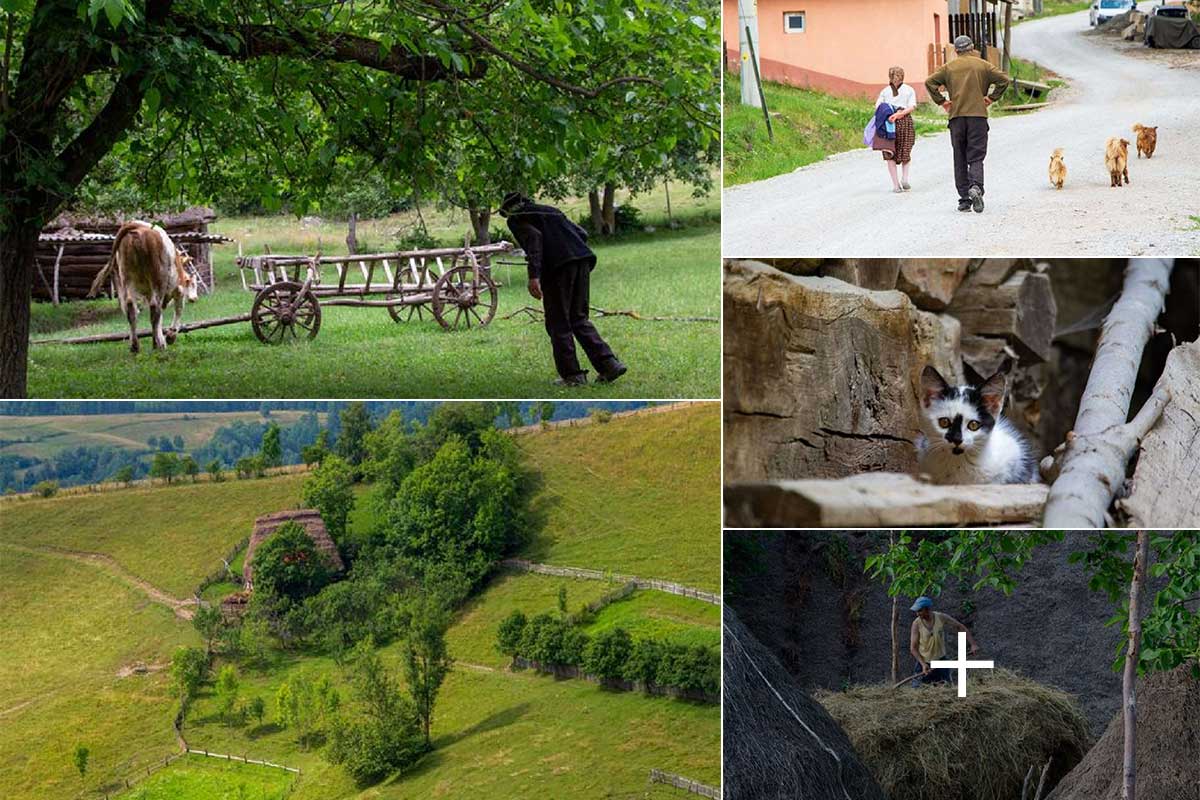
Rural life in the Apuseni mountains
(04 September 2025)
X

(04 September 2025)
Wildly romantic for some, hard work with many hardships for others—in the Apuseni Mountains, both come together. Who is happier... everyone must decide for themselves. More does not always mean better... at least not when it comes to one’s own satisfaction.
The Apuseni Mountains are a mountain range in western Romania. They reach peak heights of almost 1,850 meters (highest peak: Cucurbăta Mare at 1,849 meters) and form the northern section of the western Romanian Carpathians. The range has an almost circular shape with a diameter of 130 to 150 km, is bordered by the Mureș, Someș, and Barcău rivers, and is located in the counties of Arad, Bihor, Cluj, Alba, and Hunedoara.
We thank the photographer Gerd Deeken for allowing us to use these pictures.
The Apuseni Mountains are a mountain range in western Romania. They reach peak heights of almost 1,850 meters (highest peak: Cucurbăta Mare at 1,849 meters) and form the northern section of the western Romanian Carpathians. The range has an almost circular shape with a diameter of 130 to 150 km, is bordered by the Mureș, Someș, and Barcău rivers, and is located in the counties of Arad, Bihor, Cluj, Alba, and Hunedoara.
We thank the photographer Gerd Deeken for allowing us to use these pictures.

Deva Fortress | City of Deva | Hunedoara County
(20 August 2025)
X

(20 August 2025)
In August 2024, we followed the journey of "Schnuff" 😊 and his motorcycle friends through Romania.
https://welcome-to-romania.com | https://willkommen-in-rumänien.de
We hiked up to the Cetatea (Fortress) Deva (in German: Diemricher Burg) with a beautiful view over the city of Deva (German name: Diemrich) in Transylvania.
https://welcome-to-romania.com | https://willkommen-in-rumänien.de
We hiked up to the Cetatea (Fortress) Deva (in German: Diemricher Burg) with a beautiful view over the city of Deva (German name: Diemrich) in Transylvania.

Corvin Castle / Fortress in Hunedoara | Hunedoara County
(31 July 2025)
X

(31 July 2025)
The Hunedoara Castle (also known as Corvin Castle, in German Burg Eisenmarkt, in Romanian Castelul Corvinilor or Castelul Huniazilor, in Hungarian Vajdahunyadi vár) is one of the most important non-religious buildings in Transylvania.
https://welcome-to-romania.com | https://urlaub-in-rumänien.de
The stone castle was built on the remains of a 14th-century fortification and is located in the southwestern part of the city of Hunedoara (German name: Eisenmarkt) in western Romania.
The listed castle has many other names (Corvin Castle, Castle of the Corvins, Corvinus Castle, Corvinesti Castle, Eisenmarkt Castle, Black Castle, Vajdahunyad Castle, Hunyadi Castle), which refer to its location or its owners.
The Hungarian statesman and military leader John Hunyadi had an existing fortification converted into the ancestral seat of the Hunyadi family after 1440. In the second construction phase, the castle was expanded from 1458 under King Matthias Corvinus. At the beginning of the 17th century, further major modifications were made under Prince Gabor Bethlen. The present-day castle therefore shows a mixture of different architectural styles.
The castle was in Austrian possession from 1724 and has been in Romanian state ownership since 1918. In addition to being a tourist attraction, the castle has been and is used as a backdrop for numerous Romanian and international film productions. Today, the castle houses a museum.
We thank Tom & Helga for these beautiful pictures from their Romania tour in September and October 2024. Many thanks! 🥰
https://welcome-to-romania.com | https://urlaub-in-rumänien.de
The stone castle was built on the remains of a 14th-century fortification and is located in the southwestern part of the city of Hunedoara (German name: Eisenmarkt) in western Romania.
The listed castle has many other names (Corvin Castle, Castle of the Corvins, Corvinus Castle, Corvinesti Castle, Eisenmarkt Castle, Black Castle, Vajdahunyad Castle, Hunyadi Castle), which refer to its location or its owners.
The Hungarian statesman and military leader John Hunyadi had an existing fortification converted into the ancestral seat of the Hunyadi family after 1440. In the second construction phase, the castle was expanded from 1458 under King Matthias Corvinus. At the beginning of the 17th century, further major modifications were made under Prince Gabor Bethlen. The present-day castle therefore shows a mixture of different architectural styles.
The castle was in Austrian possession from 1724 and has been in Romanian state ownership since 1918. In addition to being a tourist attraction, the castle has been and is used as a backdrop for numerous Romanian and international film productions. Today, the castle houses a museum.
We thank Tom & Helga for these beautiful pictures from their Romania tour in September and October 2024. Many thanks! 🥰

Syrian Fortress and Municipality | Arad County
(25 July 2025)
X

(25 July 2025)
Șiria (in Hungarian Világos, in German Hellburg) is a commune in Arad County.
On the territory of today’s commune, there was already a settlement called “Villa Siri” in 1169. Vilagosvar was mentioned in documents in 1326, referring to the Vilagos fortress, today the Șiria castle ruins.
Part of Șiria’s history is the story of the 13th-century castle ruins. In 1444, the fortress briefly came into the possession of John Hunyadi, and in the second half of the 15th century, it passed to Matthias Corvinus. For strategic reasons, the Habsburg army destroyed the fortress in 1784.
Today, the castle ruins are a popular excursion destination 🥰
Photos: Iuliu Illes
On the territory of today’s commune, there was already a settlement called “Villa Siri” in 1169. Vilagosvar was mentioned in documents in 1326, referring to the Vilagos fortress, today the Șiria castle ruins.
Part of Șiria’s history is the story of the 13th-century castle ruins. In 1444, the fortress briefly came into the possession of John Hunyadi, and in the second half of the 15th century, it passed to Matthias Corvinus. For strategic reasons, the Habsburg army destroyed the fortress in 1784.
Today, the castle ruins are a popular excursion destination 🥰
Photos: Iuliu Illes

Corvin Castle / Fortress in Hunedoara | Hunedoara County
(20 July 2025)
X

(20 July 2025)
The Hunedoara Castle (also known as Corvin Castle, in German Burg Eisenmarkt, in Romanian Castelul Corvinilor or Castelul Huniazilor, in Hungarian Vajdahunyadi var) is one of the most important non-religious buildings in Transylvania.
The stone castle was built on the remains of a 14th-century fortification and is located in the southwestern part of the city of Hunedoara (German name: Eisenmarkt) in western Romania.
The stone castle was built on the remains of a 14th-century fortification and is located in the southwestern part of the city of Hunedoara (German name: Eisenmarkt) in western Romania.

Somewhere in Petrosani | Nature and tranquility... PURE
(20 July 2025)
X

(20 July 2025)
The commune of Petrosani (in Hungarian Petrozssny, in German Steinthal) is located in Hunedoara County in Transylvania.
The commune lies in the Jiu Valley, at an altitude of about 620 meters. It is known as a mining town, but the surrounding area offers a variety of wonderful destinations for trips, stays, recreation, relaxation, and more...
The commune lies in the Jiu Valley, at an altitude of about 620 meters. It is known as a mining town, but the surrounding area offers a variety of wonderful destinations for trips, stays, recreation, relaxation, and more...

Deva in the evening / at night | Reformed Church
(18 July 2025)
X

(18 July 2025)
Beautiful pictures from the evening before last from the city of Deva (in German Diemrich), here the Reformed Church. The Calvinist church is a monument of Gothic architecture. It was built between 1456 and 1526 in the late Gothic style, and in 1643 the slender, 71-meter-high tower was later added / erected.
Deva is the county seat of Hunedoara County, known for the Deva Fortress which sits high on the city’s hilltop, and is only a few kilometers from Corvin Castle / Hunedoara.
Pictures: July 16, 2025
Deva is the county seat of Hunedoara County, known for the Deva Fortress which sits high on the city’s hilltop, and is only a few kilometers from Corvin Castle / Hunedoara.
Pictures: July 16, 2025

Orăștie | Hunedoara County
(11 July 2025)
X

(11 July 2025)
Orăștie (in German: Broos, in Hungarian: Szaszvaros) is a small town and municipality in Hunedoara County, in southwestern Transylvania. The historical center of the municipality invites all visitors to relax, as well as to participate in an informative history lesson.
We thank Go Hunedoara for the permission to use these pictures.
We thank Go Hunedoara for the permission to use these pictures.

Deva at night | Wonderfully beautiful
(09 July 2025)
X

(09 July 2025)
The city of Deva is located in Hunedoara County, near the highway from Timisoara to Sibiu in Transylvania.
https://welcome-to-romania.com | https://urlaub-in-rumänien.de
We thank Go Hunedoara (Photos: Muntean Florin) for the permission to use these pictures.
https://welcome-to-romania.com | https://urlaub-in-rumänien.de
We thank Go Hunedoara (Photos: Muntean Florin) for the permission to use these pictures.
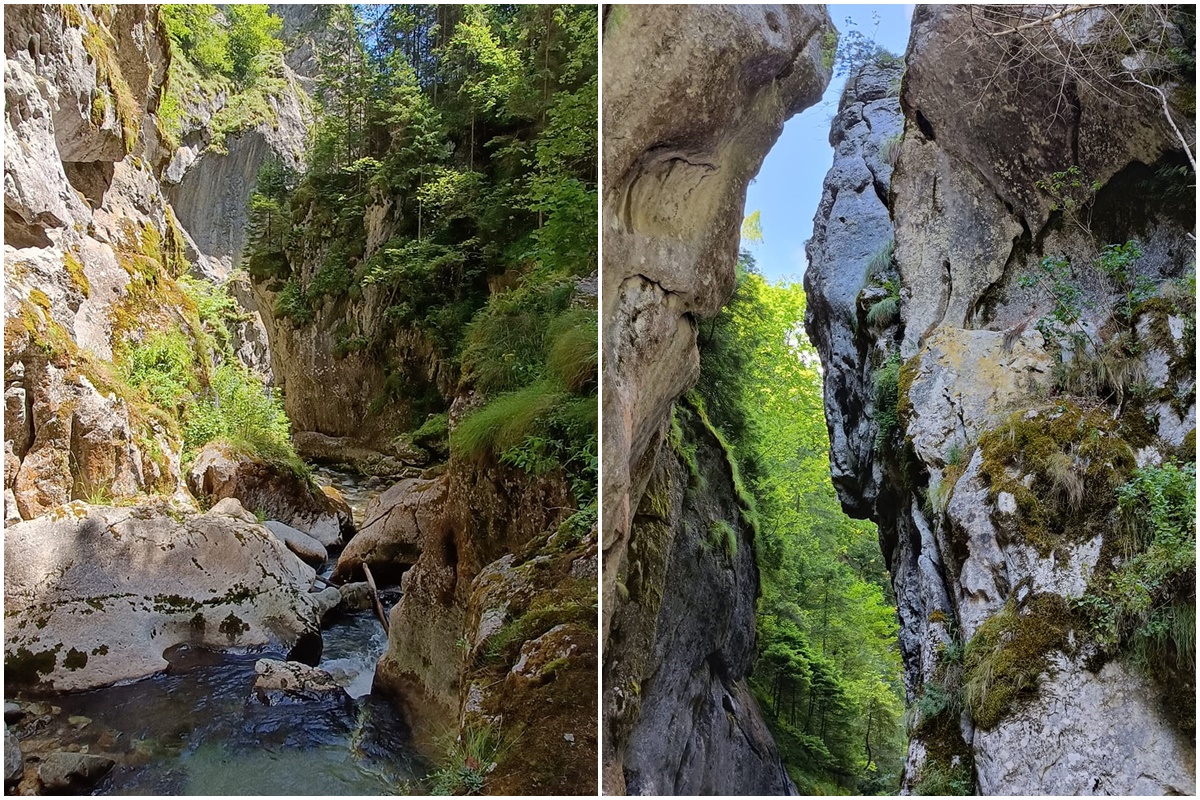
Butii Gorges | Retezat Mountains | Hunedoara County
(03 July 2025)
X

(03 July 2025)
The Butii Gorge is located in the Retezat Mountains, not far from the small town of Uricani.
Cliffs and slopes up to one hundred meters high, a series of meanders (winding bends of a stream), numerous caves, bubbling springs, waterfalls, and natural dams made of huge rocks accompany visitors who enter the gorge on an old cobbled road from Roman times.
We thank Go Hunedoara (photos: Aldo Todoran) for allowing us to use these pictures.
Cliffs and slopes up to one hundred meters high, a series of meanders (winding bends of a stream), numerous caves, bubbling springs, waterfalls, and natural dams made of huge rocks accompany visitors who enter the gorge on an old cobbled road from Roman times.
We thank Go Hunedoara (photos: Aldo Todoran) for allowing us to use these pictures.

Corvin Castle / Fortress | County / City of Hunedoara
(03 July 2025)
X

(03 July 2025)
A lot has happened in recent years, and Corvin has developed, in addition to the magnificent castle, into a history museum with many galleries.
https://xn--willkommen-in-rumnien-m2b.de/ | https://welcome-to-romania.com
https://xn--willkommen-in-rumnien-m2b.de/ | https://welcome-to-romania.com

A rose paradise | I Giardini di Zoe | Hunedoara County
(25 June 2025)
X

(25 June 2025)
Experience a rose paradise in the I Giardini di Zoe park in the village of Banpotoc, Hunedoara County. It is a fairytale place where, in a perfectly maintained Italian garden, thousands of roses bloom spectacularly every summer.
Fragrant alleys, green arches, fountains, and cobblestone paths transport you to a dream world where nature blends with the classical elegance of Renaissance gardens. During this time, the roses are in full bloom – a true visual and olfactory spectacle. Every corner of the garden is a perfect opportunity for unforgettable photos!
We thank Go Hunedoara for permission to use these images.
Fragrant alleys, green arches, fountains, and cobblestone paths transport you to a dream world where nature blends with the classical elegance of Renaissance gardens. During this time, the roses are in full bloom – a true visual and olfactory spectacle. Every corner of the garden is a perfect opportunity for unforgettable photos!
We thank Go Hunedoara for permission to use these images.
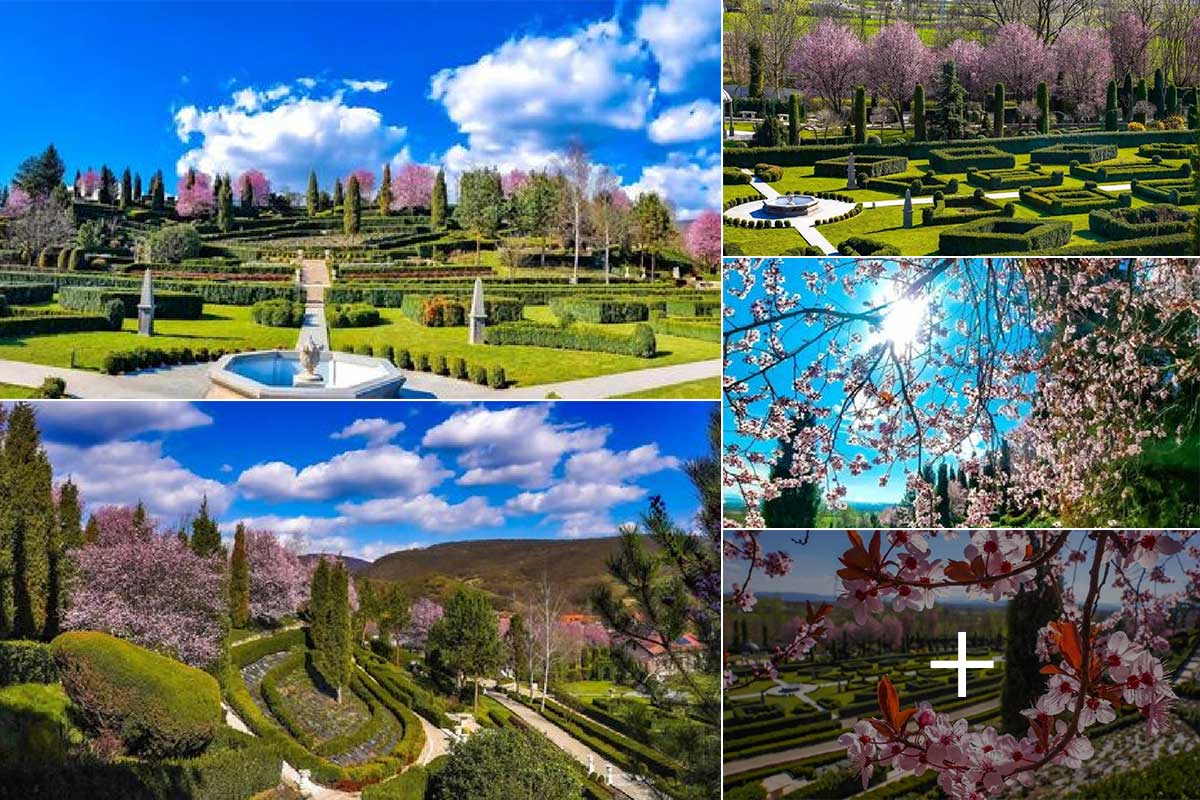
I Giardini di Zoe | Hunedoara County
(24 June 2025)
X

(24 June 2025)
Beautiful pictures of the botanical garden "I Giardini di Zoe" from March 2024.
The garden, also known as Banpotoc Garden, is located east of the city of Deva (in German Diemrich), on the left side of the A1 motorway (heading towards Sibiu), in the Banpotoc village of Harau commune.
We thank Go Hunedoara for granting permission to use these images.
The garden, also known as Banpotoc Garden, is located east of the city of Deva (in German Diemrich), on the left side of the A1 motorway (heading towards Sibiu), in the Banpotoc village of Harau commune.
We thank Go Hunedoara for granting permission to use these images.

Deva at night | Absolutely beautiful
(21 June 2025)
X

(21 June 2025)
The city of Deva is located in Hunedoara County, near the highway connecting Timisoara to Sibiu in Transylvania.
We thank Go Hunedoara (Photos: Muntean Florin) for the permission to use these images.
We thank Go Hunedoara (Photos: Muntean Florin) for the permission to use these images.
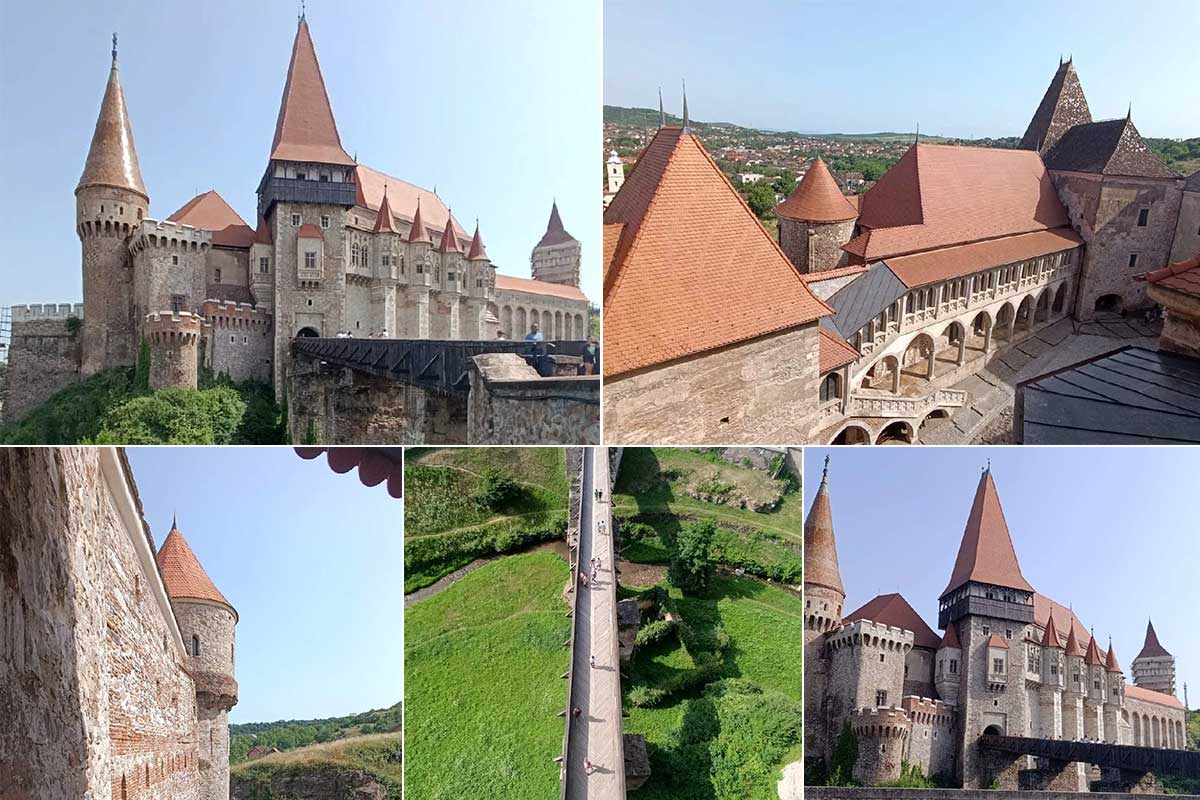
Beautiful photos | Corvin Castle / Fortress in Hunedoara
(21 June 2025)
X

(21 June 2025)
Hunedoara Castle (also known as Hunedoara Castle, in German Burg Eisenmarkt, in Romanian Castelul Corvinilor or Castelul Huniazilor, in Hungarian Vajdahunyadi var) is one of the most important non-ecclesiastical buildings in Transylvania.
The rock castle was built on the remains of a 14th century fortification and is located in the south-western part of the town of Hunedoara (German name: Eisenmarkt) in western Romania.
We would like to thank Mr. Camille Feller and his wife Katja Feller for sending us these beautiful pictures and giving us permission to use them. Thank you very much!
The rock castle was built on the remains of a 14th century fortification and is located in the south-western part of the town of Hunedoara (German name: Eisenmarkt) in western Romania.
We would like to thank Mr. Camille Feller and his wife Katja Feller for sending us these beautiful pictures and giving us permission to use them. Thank you very much!







